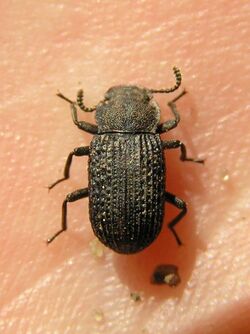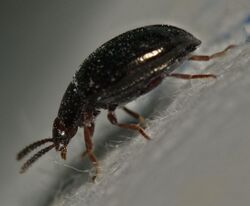Biology:Tenebrioninae
| Tenebrioninae | |
|---|---|

| |
| Blaps mortisaga of tribe Blaptini | |
| Scientific classification | |
| Domain: | Eukaryota |
| Kingdom: | Animalia |
| Phylum: | Arthropoda |
| Class: | Insecta |
| Order: | Coleoptera |
| Infraorder: | Cucujiformia |
| Family: | Tenebrionidae |
| Subfamily: | Tenebrioninae Latreille, 1802 |
| Tribes | |
|
Around 20-30, see text | |
Tenebrioninae is the largest subfamily of the darkling beetles (Tenebrionidae), containing flour beetles, among others. Tenebrioninae contains more than 20 tribes.
Description

Adults
Adults are robust, mid-sized beetles that typically have elytra with some sort of corrugation on the upper side. They are typically black, dark brown or grey, and often have a satiny sheen. The body is shaped like a medication capsule or like a bullet; the legs can be short and stout or long and spindly. They eat both fresh and decaying vegetation, including vegetable produce, and several are commercially important pests of flour and other cereal products.
The subfamily has been characterized[1] as adults having mandibles with the back opposite the cutting edge, without margination and excavated opposite the molar pait; having ocelli arranged in two transverse, crescent shaped or circular groups on each side of head, and with five more or less fused lenses; having antennae with basal articles noticeably longer than wide; having pygidium that is apically bicomute; and having abdominal spiracles that are oval and transverse, among other characteristics.
Larvae
Larvae of the tenebrioninae subfamily take after most other tenebrionid larvae:[2] usually cylindrical to slightly flattened, occasionally short and broad, or strongly flattened. The head and all visible tergites or only the head and abdominal apex are heavily sclerotized.
Diagnostic characters for larvae include the presence of a frontoclypeal suture, flat and dome-like antennal sensorium, simple malar apex which is not cleft, simple ninth sternum, annular or annular- multiforous spiracles, and the absence of an endocarina, mandibular prostheca, hypostomal rods, ventral prolegs, and patches or rows of tergal asperites.
Notable species
Larvae of the yellow mealworm beetle (Tenebrio molitor) are commonly used as feeder insects for reptiles and amphibians. Other Tenebrio and Tribolium species are also bred as animal food. The red flour beetle (Tribolium castaneum) is a popular genetics model organism, especially in studies of intragenomic conflict and population ecology.
Several species of Tenebrio and Tribolium, such as the confused flour beetle (T. confusum) and T. destructor, and other genera such as Gnathocerus cornutus, are pests of cereal and flour silos and other storage facilities.
Systematics
File:Blaps mucronata - 2012-10-25.webm
The Tenebrioninae are traditionally divided in some 20-30 tribes. The exact delimitation and validity of several of these is unclear. Molecular phylogenetic studies have yielded inconsistent results, perhaps due to hybridization, horizontal gene transfer by Wolbachia bacteria, and insufficient taxon sampling obfuscating the information contained in DNA sequence data.[3][4]
In some treatments, the Pimeliinae are included as yet another tribe. This may be correct, but as far as can be told they are a closely related but well distinct lineage of Tenebrionidae. The Opatrini are sometimes elevated to familial rank as Opatrinae. The Crypticini, Pentaphyllini, and Scaphidemini are sometimes placed here, but are more commonly located in the Diaperinae.[3][4]
In research by Kamiński et al. published in 2021, the following tribes were moved from Tenebrioninae into the newly resurrected subfamily Blaptinae. These tribes contained 281 genera and about 4000 species, about 50% of Tenebrioninae. The new classification was followed by Bouchard et al. the same year.[5][6]
- Amphidorini LeConte, 1862
- Blaptini Leach, 1815
- Dendarini Mulsant & Rey, 1854
- Opatrini Brullé, 1832
- Pedinini Eschscholtz, 1829
- Platynotini Mulsant & Rey, 1853
- Platyscelidini Lacordaire, 1859
The resulting Tenebrioninae, according to "Review of genus-group names in the family Tenebrionidae" (Bouchard et al. 2021), includes the following tribes:[6]
- Acropteronini Doyen, 1989
- Alphitobiini Reitter, 1917
- Amarygmini Gistel, 1848
- Apocryphini Lacordaire, 1859
- Bolitophagini W. Kirby, 1837
- Centronopini Doyen, 1989
- Cerenopini Horn, 1870
- Dissonomini G.S. Medvedev, 1968
- Eulabini Horn, 1870
- Falsocossyphini Ferrer, 2006
- Heleini Fleming, 1821
- Helopini Latreille, 1802
- Melanimonini Seidlitz, 1894 (1854)
- Metaclisini Steiner, 2016
- Palorini Matthews, 2003
- Paoligenini Ferrer, 2013
- Praeugenini De Moor, 1970
- Rhysopaussini Wasmann, 1896
- Scaurini Billberg, 1820
- Scotobiini Solier, 1838
- Tenebrionini Latreille, 1802
- Titaenini Fauvel, 1905
- Toxicini Oken, 1843
- Trachelostenini Lacordaire, 1859
- Triboliini Gistel, 1848
- Ulomini Blanchard, 1845
In addition, the following genera are of uncertain placement in this subfamily:
- Anophthalmolamus Ferrer, 1993
- Hangaya Matthews & Merkl, 2015
- Penichrus Champion, 1885
References
- ↑ St. George, R. A. (1924) (in English). STUDIES ON THE LARVAE OF NORTH AMERICAN BEETLES OF THE SUBFAMILY TENEBRIONINAE WITH A DESCRIPTION OF THE LARVA AND PUPA OF MERINUS LAEVIS (OLIVIER).. Proceedings of the United States National Museum: Bureau of Entomology, United States Department of Agriculture. pp. 2–3.
- ↑ "Introduction to the Darkling beetles of Eastern United States and Florida". https://entnemdept.ufl.edu/teneb/intro.htm.
- ↑ Jump up to: 3.0 3.1 Angelini, D. R. & E. L. Jockusch. (2008). Relationships among pest flour beetles of the genus Tribolium (Tenebrionidae) inferred from multiple molecular markers. Molecular Phylogenetics and Evolution 46(1) 127-41. doi:10.1016/j.ympev.2007.08.017 (HTML abstract)
- ↑ Jump up to: 4.0 4.1 Bouchard, P. (2005). "Synoptic classification of the world Tenebrionidae (Insecta: Coleoptera) with a review of family-group names". Annales Zoologici 55 (4): 499–530. http://www.tenebrionidae.net/newdesign/papers/bouchard.pdf.
- ↑ Kamiński, Marcin; Lumen, Ryan; Kanda, Kojun; Iwan, Dariusz et al. (2021). "Reevaluation of Blapimorpha and Opatrinae: addressing a major phylogeny-classification gap in darkling beetles (Coleoptera: Tenebrionidae: Blaptinae)". Systematic Entomology 46: 140–156. doi:10.1111/syen.12453. https://www.researchgate.net/publication/343547593.
- ↑ Jump up to: 6.0 6.1 Bouchard, Patrice; Bousquet, Yves; Aalbu, Rolf L.; Alonso-Zarazaga, Miguel A. et al. (2021). "Review of genus-group names in the family Tenebrionidae (Insecta, Coleoptera)". ZooKeys (1050): 1–633. doi:10.3897/zookeys.1050.64217. PMID 34385881. PMC 8328949. https://zookeys.pensoft.net/article/64217/.
Wikidata ☰ {{{from}}} entry
 |








